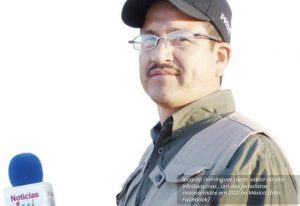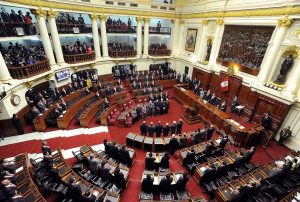The main factors that made possible the environment of violence that the Ecuadorian press has been exposed to during the national strike for the last two weeks are the stigmatizing rhetoric that sees the media as the enemy and the impunity that dominates the attacks against journalists. country.
This is the view of many organizations defending freedom of expression, condemning the wave of attacks that took place in various cities of the country during the demonstrations organized by indigenous leaders and other Ecuadorian union organizations since 13 June.
Protesters are demanding that the government of President Guillermo Lasso lower fuel prices, cancel debts to indigenous peoples, set fair prices for agricultural products, and increase the budget for health and education, among other demands.
Journalists face widespread attacks in Ecuador
“There is a very serious atmosphere of violence against the press. “There have been incidents of violence, such as attacks on journalists with stones, sticks, objects or boiling liquids, and no cover-up is allowed,” said César Ricaurte, director of the Fundamedios organisation.
“There was widespread violence in the context of the strike. It has been something permanent, systematic and pervasive,” he said.
As of 28 June, Fundamedios had recorded 142 attacks on 159 people, including journalists (86), cameramen (27), photojournalists (9), media (8), communicators (5), assistants (4), web pages. (4) and human rights defenders (4). Eight of the attacked journalists were attacked more than once.
The organization stated that in 117 cases of violence, the aggressors were protesters; security forces agents in 14 cases; 13, on unknown issues; officers at 6; 4 non-state attackers; in 4, political figures; and in one case, an indigenous leadership.
Speeches by protesters in Ecuador accuse journalists of corruption
The most common attacks were physical attacks, with a total of 65.
There were 49 threats, 17 stigmatizing speeches, 10 denied access to information, 6 digital space restrictions, 5 equipment thefts, 4 arrests, 2 equipment destruction and 1 illegal due process cases. to the norms.
The recorded attacks were carried out in the provinces of Pichincha, Guayas, Cotopaxi, Bolívar, Pastaza, Imbabura, Morona Santiago, Napo, Chimborazo and Zamora Chinchipe.
“The attacks come mainly from protesters who accuse the media and journalists of being biased political actors in the national strike called by the indigenous movement,” said Voces del Sur, a network of regional organizations that defend press freedom and protect journalists. June 23.
“[…] All this in the midst of a discourse in which the existence of journalists is constantly denied and the work of the media is stigmatized.”
One of the most repeated slogans of the protesters in their verbal attacks on the media was the “corrupt press”.
The phrase was popularized by former President Rafael Correa as part of his discrediting campaign against journalists and the media through official radio and television media during his 10 years in power.
Read more
UNESCO: 14 of 55 murders of journalists in 2021 took place in Latin America
This stigmatizing discourse, referring to a press in the service of the government or other power sectors, permeated social movements such as the indigenous movement leading the current national strike.
“If you listen to the conversations, the press factor is always found to be the enemy. This is something that is also being addressed by district and community leaders. “If we start to examine the discourse of indigenous leaders, we will see that it is a generalized discourse against the press,” he said.
“What this does is justify saying, ‘I am legitimized because the moment I attack a journalist, I am attacking someone who is my so-called enemy.
The press is seen as the enemy of the protesters
Indigenous movement leaders have repeatedly blocked their movements from being reported on the grounds that the traditional media in Ecuador did not tell the truth and did not adequately reflect their voices.
According to the director of Fundamedios, there is an opinion that if the press does not adhere to the truth of the indigenous leaders, they are enemies.
“There is the media that criticizes the indigenous movement and these mobilizations. But even these media outlets have the right to cover and do their work safely without being exposed to aggression and conditions in which they cannot do their work.”
“This is part of the democratic game, the existence of different editorial lines and this is what feeds the plurality of the media landscape,” he emphasizes.
In response, the Voces del Sur network reminded the leaders of the national strike that journalists are not political actors and that their duty is to gather all voices so that citizens are aware of the diversity of events.
“We condemn these attacks and call on the state and social organizations that support the mobilization to provide the necessary protection and guarantees for the development of journalistic work and to recognize the importance of the work of the press and journalists in this context,” the organization said. in his statement.
Other violence against journalists recorded in Ecuador
The impunity for violence against the press in recent years is another factor fueling the attacks during the current national strike.
In October 2019, Ecuador was the scene of serious attacks on media outlets amid a series of other demonstrations.
Among the most serious cases of that period were the attempt to burn down the Teleamazonas channel, the detention of a group of journalists by protesters, and the attack on journalist Freddy Paredes, who was stoned to the hospital.
According to the newspaper El, the Ecuadorian Public Ministry only investigated the Paredes case and sentenced the attacker, a temporary employee of the Ecuadorian National Electoral Council, to four and a half months in prison and to pay $2,000 in damages that he had not paid. pais.
“There is no other case being prosecuted or investigated. “There is absolutely no exercise of justice to investigate or punish attacks on the press,” Ricaurte said.
Read more
Peru wants to punish the release of information about criminal investigations to the press
Social organizations and international organizations fear that the wave of attacks that began on 13 June could lead to a human rights crisis for citizens, particularly their right to be properly informed.
In a statement released on 20 June, Amnesty International said the criminalization of journalists and human rights defenders in Ecuador, as well as multiple allegations of harassment and excessive use of force, “caused a human rights crisis reminiscent of October 2019”.
In response, the Inter-American Commission on Human Rights (IACHR) and the Special Rapporteur on Freedom of Expression (RELE) asked officials and social leaders to refrain from attacking or stigmatizing the press.
They also reminded us of the importance of journalists reporting the mobilizations well for the good of the citizens.
“[…] Addressing social protests as journalism in conditions of security and freedom is essential so that citizens can access information and opinions about the allegations from as many and diverse perspectives as the society. June.
“Lack of access to information has the potential to affect the voice of both corporate and civil society, hinders social understanding of the environment and distances them from resolving conflicts.”
Journalists for safety drop coverage of demonstrations in Ecuador
The news received by the citizens of Ecuador was also affected by the self-censorship chosen by some journalists to ensure their physical integrity, particularly front-line reporters and those in the television media.
“Television coverage is now quite far away, crews are no longer at the location of the marches, where they can zoom in or send a drone to take pictures of a walkway or nearby building,” Ricaurte told LJR. .
“But there is no more coverage on the front line of marches. And frankly, it’s a pretty reasonable measure of self-protection.” You can see a trend towards self-censorship in the news of the marches,” he said.
According to the organizations, although the active attackers of the media are predominantly protesters and security forces, the state’s inaction against the attacks and hostility to the media has allowed the violence against the media to spread unhindered.
Read more
India uses ‘religious insult’ as reason to arrest Modi government journalist
“The state did not articulate enough actions to secure the job of the press. “This adds to the dangerous speeches of local leaders who one day demand respect for the press and the next day accuse the media of sowing hatred and violence.”
The network also stressed: “This creates a negative environment for freedom of expression, press and access to information”.
For Fundamedios, not only the current government is responsible, but also the previous governments of Lenín Moreno and Rafael Correa, where there was no effective action to protect media workers.
“The state is responsible for negligence in this case. “In Rafael Correa’s decade, the government was the main aggressor against the press, but what existed in the next two governments was complete inaction in practice,” he said.
“No public policy has been adopted for the protection and safety of journalism. Everything, like the creation of the committee to protect journalists, remained in the proposals, the shortened experiences”.
*César López Linares began his career as an entertainment and media co-editor at the Mexican newspaper REFORMA. He has written for publications such as TODO Austin, Texas Music Magazine, and The Austin Chronicle. César holds a master’s degree in journalism from the University of Texas at Austin and a BA in communications from the Universidad Nacional Autónoma de México. She writes about innovation in journalism for the Gabo Foundation and Knight Center’s LatAm Journalism Review blog in Colombia.
This article was originally published in LatAm Journalism Review, a project of the Knight Center for Journalism / University of Texas in the Americas. All rights belong to the publication and the author.
read it too
source: Noticias
[author_name]


